
Not far away and on the way to Ponte Vecchio there’s the strawmarket
and the bronze porcellino - a little pig. A few coins of Lire you have
to roll from the pig's nose into a hole to its feet and you’re coming
back to Florence. If you’re superstitious. But I'm not. Also the
Trevi-fountain in Rome has never seen my money.
Well... let's go on
to Ponte Vecchio. You know the bridge over the river Arno, that is
crammed with small to tiny shops. When it was built in the 14th century
only meat slaughterers and butchers had their domicile there, who used
to throw all their litter into the river. It was Duke Cosimo I who put
an end to the practice because he felt annoyed by the stench. After all
he had to cross the Vasari-corridor when he wanted to go from the town
hall to the Pitti Palace, his home. And the corridor leads directly
over this bridge. So he banished the butchers on the spot and
established instead goldsmiths and jewellers. On early Sundays their
closed shops are looking like old jewel boxes with heavy locks and
keys outside. But today isn't Sunday and the bridge is bursting with
tourists.
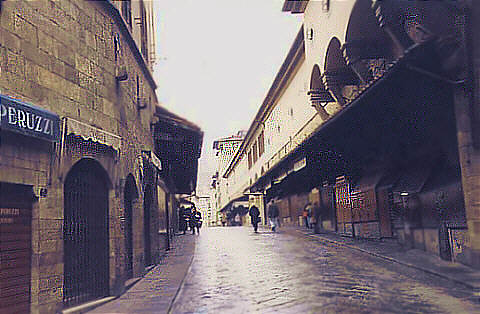
From outside the bridge looks better than if you're standing on
it - assuming you aren't interested in gold, like us. There's a
bronze-monument for Benvenuto Cellini, the narcissistic representative
of the goldsmiths' art ... and soon the rush is behind us.
Oh, did I mention that Ponte Vecchio was the only bridge that wasn't
destroyed by the German Wehrmacht? In 1944 they bombarded Florence bridges,
but Hitler himself had apparently fallen in love with the bridge and
on his assertive order it wasn't detonated.
It's getting hot while we're on the way to Palazzo Pitti. You have to
swallow a lot of exhaust valves and fumes because the pavements in
Florence are small everywhere, which is good for the cars but in no
way good for pedestrian. Luckily the Florentines (like every Italian)
are excellent drivers otherwise the number of tourists lying under
a car or bike would rise to astronomical heights. Anyhow, it's annoying
enough. Therefore the splendid Boboli-garden is an all too welcomed
change.
The Pitti Palace was built by Ammannati (you remember the
Neptune-fountain) for the Dukes of Tuscany, represented by the family
of Medici (who else?). It's a gigantic, light brown facade, a tarred
place in front of it (where several teens are resting in the broody
sunshine), but I long for shade. Nowadays the town demands
an entrance fee, because too much of the garden had been destroyed
(did I tell you before that I was wondering how the town managed
to avert vandalism?) Oh well... Some of the statues were smeared
and arms and heads were missing, so the city fathers decided to get
the money from the tourists. I guess, it's just fair enough. It's
pure nature in an otherwise tree- and branchless town. There's a
turtle-fountain whose basin comes from the Diocletian-termi in Rome
and the obelisk in between directly from Egypt. The rise is steep
and tiring but as reward a cafe-house is waiting. But a cafe-house
with more than a stupendous outlook. The whole town of Florence is lying
at our feet...

Later there's the Forte Belvedere, even higher than the cafe. There's
a terrace among old villas and oil trees. Tuscany itself just a few steps
aside from the hurly-burly of the town. There's an eternity of looking
and looking but it doesn't help, we have to go finally passing the
grottos of
Buontalenti on our way down. Built from some strange ideas they
once housed Michelangelo's "slaves" (now in the Accademia-museum), from the
darkness peers odd sculptures and there's the favourite dwarf of
Cosimo I. It's a women's habit to stroke the little penis in case
they want kids. Well.... perhaps we have other reasons ;-)
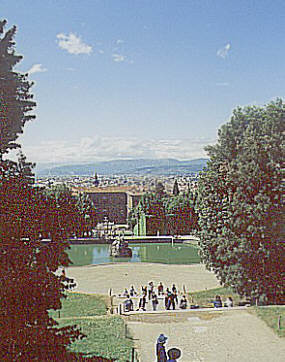 Another evening falls. In the search for a restaurant we stroll through
the oldest part of the town. It's the Dante-quarter, interlarded with
housing-towers of the Ghibellins and the Guelphs. It's supposed Dante
was born here, although nobody can say for sure which house. On the
walls are hanging plates with quotes from the "Divine Comedy". I
remember the only quote I know: "Through me leads the way to town of
pain. Through me leads the way to everlasting mourning. Through me leads
the way amid the lost people. Lasciate ogni speranza voi ch'entrate.
Let all hopes die, you, who enter." That's the inscription over the
gate to hell.
Another evening falls. In the search for a restaurant we stroll through
the oldest part of the town. It's the Dante-quarter, interlarded with
housing-towers of the Ghibellins and the Guelphs. It's supposed Dante
was born here, although nobody can say for sure which house. On the
walls are hanging plates with quotes from the "Divine Comedy". I
remember the only quote I know: "Through me leads the way to town of
pain. Through me leads the way to everlasting mourning. Through me leads
the way amid the lost people. Lasciate ogni speranza voi ch'entrate.
Let all hopes die, you, who enter." That's the inscription over the
gate to hell.
It's so dark you actually need a torch. Who's afraid of the ghost of
the Middle Ages? The ghosts of plague, of death and of murder?
Now we are crossing the place of the former notorious jail, which is
today the Verdi-theatre. We are crossing Via del Corso: in the middle
ages clattered the hooves of Berber horses over the paving. The winner
got the Palio - a banner - on dark red brocade a lily and a red cross:
that's Florence's coat of arms. The walls are also decorated with the
lamb and the cross: the sign of the Arte Lana (the wool weavers) and
the balls of the Medici (sorry, not THE balls, ouch). There are nine
balls or circles on a plate, Probably because they are matching their
names well, doctors are using pills, don't they.
The next day there's Fiesole to conquer. The summer residence of the
Florentine in the hills high over the town.
It's an old Etruscan town, much, much older than Florence. You remember
the soldier veteran's who founded Florence. But the valley wasn't
exactly healthy, you know. Malaria and marsh fever made the people
suffer, not to mention the terrible heat in summer. So they realized
why the Etruscan hadn't been so daft to settle here. It was easy for
the Romans to conquer Fiesole and made the free Etruscan tribe their
slaves. Why did the Romans always have to conquer? Anyway, the summer resort
of Fiesole was now Roman.

On the way up we pass beautiful villas, splendid gardens, blooming
roses and lilies and red poppies. Not far from here are the
Medici-mansions where Lorenzo succumbed to the family disease gout.
The outlook is great: A cherished garden's landscape, in between dark
green cypresses, hills are drawing soft rounds, red tile roofs are
looking down to the valley. Once more Florence is lying at our feet.
A Postcard's landscape.
Final station is the Piazza Mino da Fiesole (a painter and architect)
where we are greeted by the inescapable monument "Meeting of Garibaldi
with king Victor Emanuel". If you're in Italy and unsure about a
monument that shows two guys be sure it's always Garibaldi and Victor.
Fiesole houses a fine museum for Etruscan art and roman excavations.
Part of it is in a building, the other part is outdoors, like the
amphitheatre. You stay and look down the semicircle, small seats and
the old settings. You can look far into the valley of Mugello. The
family of Medici came from the valley of Mugello. They were farmers
and peasants actually. You know the proverb: Trade has a golden ground
or something.
Blue hills are blurring in the distance. You can follow down the path
to the excavations. Long lines of graves, old pedestals of urns,
guarded by black cypresses, the classic cemetery-tree. We stroll under
olive trees through freshly mowed grass. It smells for hot hay and
herbs. It's quiet and only the birds are singing. At last there's the
ruins of the Roman hot springs. You can see the basins for the warm
bath, the exposed under floor heating and the pipes where the cold
water was carried up from the Arno to be heated up here. It's a truly
romantic place.
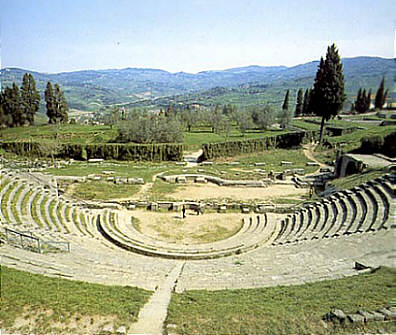
There's a steep lookout. But the weather is a little hazy, so Florence
vanishes in a foggy haze. Anyway, there's still the duomo San Romolo
to visit. It's a Romanic, red-brown chunk of tiles that resembles
Palazzo Vecchio. In the very dark crypt under the altar burns the
eternal light in front of the translucent sarcophagus where the
bones of Holy Romolo are lying.
Fiesole can be a starting point for walking through the valley of
the Mugello and it's highly recommended. Back in Florence you can
drift in the gloomy alleys. Or look what the price lists are saying
in the noble restaurants on Piazza Repubblica. Troppo caro I'd say.
Tourists' rip off. The straw market is emptying, the merchants packing
back their odds and ends, the porcellino is deserted. The sun is
throwing long shadows on the Piazza Signoria. Tourist and inhabitants
enjoy the last beams in the garden of the "Rivoire" one of the best
restaurants and cafes in town.
The next day San Lorenzo is on our agenda, passing the duomo and the
baptistery. Did I mention that the doors to this building are most
precious? By the 14th century plans were already under way for the
creation of the new doors which also had to be worthy of the monument.
The sculptor Andrea Pisano was commissioned with the first pair,
which he carried out between 1330 and 1336, while Lorenzo Ghiberti
designed and made two sets of doors one pair he finished in 1424.
The other pair between 1425 and 1452.
Both are of bronze (four pairs on each direction), but the latter pair
is gilt. It's the "Doors to Paradise" as Michelangelo said, when he was
still a teenager, standing admiringly in front of them. It's not the
beauty exactly what makes them so precious, but it's the complete new
invention how it was planned and made finally. Not a flat plate with
lots of figures but each detail was worked so that it looks three
dimensional like a scene you can touch (but you mustn't). Since
the originals floated through the town when in 1966 a big flood
threw Florence into a catastrophe they are protected in the museum
of the cathedral. But the copies are precious as well.
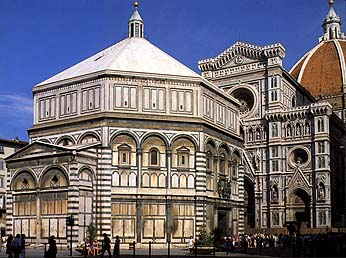
Dante himself declared that his "beautiful San Giovanni" (That's the
name of the baptistery) was a classical Roman building. The foundation
of the first building dates from the 4th century and got its
octagonal shape later. It had the function of a cathedral then and became
an official part of history in March 897, when Amadeo, the Count
Palatine and envoy of the Emperor, sat beneath the portico in front
of the "Basilica of San Giovanni Battista" to administer justice. Mid
12th century the external revetment of the baptistery was started. It's
a masterpiece of white Carrara an green Prato marble inlay,
geometrically designed in a harmonious classical style to cover the
original sandstone. Already it shows signs of the search for spatial
delimitation that lead to the perspective of the Renaissance.
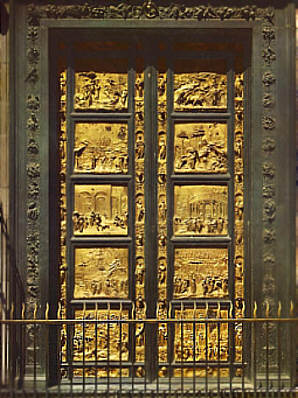 Inside the large basin where Dante had been christened is vanished.
But a huge Christos Pantokrator is looking down on you, as mosaic of
course.
Inside the large basin where Dante had been christened is vanished.
But a huge Christos Pantokrator is looking down on you, as mosaic of
course.
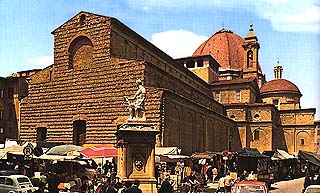
If you step out from a small sideway you are on the backside of San
Lorenzo. Our look wanders up to the red tiled egg of the Duke's chapel.
"Ingresso Cappella di Medicee". My heart beats faster because I have been
looking forward to this the whole time.
First there's a low, white crypt. Almost all members of the Medici-family
are buried here to the last member Maria Ludovica. It's her merit that
we can find Florence as it was in her time in the 18th century. Just
before she died without having heirs she bequeathed all the Medici-possession
to the town, on condition that nothing, absolutely nothing should be
sold. Just lent. Perhaps. The government of Florence fulfilled this
last wish until today.
The entrance to the Duke's chapel. The tombs of the six big Medici-Dukes.
You stay and are dazzled. Not because it is so splendidly decorated with
gold, no. Nothing in Florence is decorated with gold. It consists from
up to down with Pietra-Dura: Stone-in-stone-intarsia. That's a Florentine
speciality, which the workers still control (the large ground was finished
just a few decades ago). You pass the 16 Tuscany coat of arms. There's
the red lily on white ground. Sienna's black and white coat. The black
half moon of Fiesole. Lucca, Pisa, Volterra, corals, mother of pearl
and the bright blue of the lapis lazuli. I touch the cool, smooth stone.
The cupola is covered with freschi painted in the last century. The
Old and the New Testament: huge pictures with unbelievable brilliance,
and above all that unearthly blue....
It's hard to go, but the next highlight is waiting: The New Sacristy,
completely worked by Michelangelo.
Even more?





 Another evening falls. In the search for a restaurant we stroll through
the oldest part of the town. It's the Dante-quarter, interlarded with
housing-towers of the Ghibellins and the Guelphs. It's supposed Dante
was born here, although nobody can say for sure which house. On the
walls are hanging plates with quotes from the "Divine Comedy". I
remember the only quote I know: "Through me leads the way to town of
pain. Through me leads the way to everlasting mourning. Through me leads
the way amid the lost people. Lasciate ogni speranza voi ch'entrate.
Let all hopes die, you, who enter." That's the inscription over the
gate to hell.
Another evening falls. In the search for a restaurant we stroll through
the oldest part of the town. It's the Dante-quarter, interlarded with
housing-towers of the Ghibellins and the Guelphs. It's supposed Dante
was born here, although nobody can say for sure which house. On the
walls are hanging plates with quotes from the "Divine Comedy". I
remember the only quote I know: "Through me leads the way to town of
pain. Through me leads the way to everlasting mourning. Through me leads
the way amid the lost people. Lasciate ogni speranza voi ch'entrate.
Let all hopes die, you, who enter." That's the inscription over the
gate to hell.



 Inside the large basin where Dante had been christened is vanished.
But a huge Christos Pantokrator is looking down on you, as mosaic of
course.
Inside the large basin where Dante had been christened is vanished.
But a huge Christos Pantokrator is looking down on you, as mosaic of
course.


